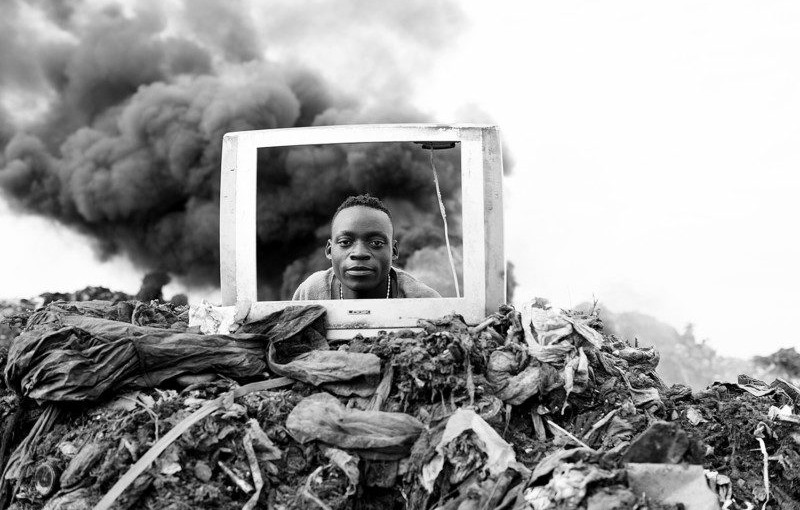Mozambique: Stewart Sukuma and Remna Schwarz Schwarz in Maputo concert this Tuesday
Online voting ends Friday: Mozambique’s Macilau shortlisted for Greenpeace Photo Award

Mário Macilau 'The Profit Corner' / A young boy playing behind a TV frame at the Hulene Dumpsite in Maputo, there you can find a lot of electronics, which are destined for its end but people who lives and works there by recycling them for reuse or to resale some times they have to deal with the factual reality due the huge number of pieces without any chance to be re- used. Electronics are causing serious health and pollution problems, mostly as Mozambique is one of the countries worldwide that have limited regulatory oversight of e-waste processing.
Renowned Mozambican photographer Mário Macilau has been shortlisted among 11 candidates for the Greepeace Photo Award 2016 with his project ‘The Project Corner’ , a series of photographs of the Maputo Municipal open pit waste dumpsite. Hulene Dump. Voting end on Fiday, September 30, and you can visit the project here http://photo-award.org/?lang=en and vote for Macilau here http://photo-award.org/mario-macilau/?lang=en
Your votes decide which photographer will receive a production grant from Greenpeace to realise his or her project. The photo project with the most votes wins the audience award and a grant of 10’000 euros. There are also two jury awards of 10’000 euros each.
The current leader in the polls will be revealed to you only after you cast your vote. You can only vote once. The polls are open until September 30. The vote count of October 1, 2016 is final.
The three winners will be announced in early October. The winning projects will be produced and published in 2017. The two jury prize winners will be featured in GEO and the audience award winner in the Greenpeace magazine.
Macilau’s ‘The Profit Corner’
The Maputo Municipal open pit waste dumpsite, over fourth years old, after Mozambique gained independence it has turned into a significant livelihood for people without any other perspective, there you can find a group of more than two thousand people who make a living out of the e-waste, either by separating and selling recyclables goods such as TVs, Computers, tablets and mobiles or by living out of whatever they find to be edible or useable. The dump is located seven kilometres from downtown Maputo, the capital of Mozambique and its largest city. There is no treatment of garbage and the Hulene Dump is the only destination for all the garbage that the city produces. Waste burning has been going on continuously in the dumpsite for over twenty years, representing a serious public health hazard, in particular to those who are living there (or surviving).
Global e-waste is piling up fast. According to a study of the United Nations University more than 40 million tons of electronic waste were generated in 2014. Only one sixth of it is disposed of properly and recycled. Electronic devices and smartphones contain minute quantities of poisonous metals. The users of such devices are generally not at risk, but once the devices have outlived their usefulness and are dismantled the toxic substances are released. They pollute the environment and harm the health of anyone who comes in contact with them.
Mozambique is among the least developed countries in the world but in recent years it has intensified the exploitation of its natural resources, achieving an average annual growth of almost 7 percent since 2006. Especially in the capital Maputo the signs of this development are hard to ignore. Sales of cell phones, flat screen televisions, digital cameras and computers are steadily increasing. That creates new problems: broken or outdated devices end up in the sprawling Hulene landfill, seven kilometres from the city centre.
For many people living on the margins this garbage dump is both home and workplace. Recyclable waste—especially from electronic devices—is their livelihood. Over open fires from burning tires they separate valuable metals from circuit boards for resale. In the process, heavy metals leak into the soil and poisonous vapors destroy the surrounding areas and the workers’ health.
Photographer Mário Macilau plans to continue the project he already started on the Hulene dump and will document the daily lives of its workers over a period of several months. Through his images he confronts consumers with the consequences of their voracious appetite for new electronic devices. In Macilau’s narrative the life cycle of electronic products is transformed into a cycle of sickness and death.
Mário Macilau (born 1984) grew up in the streets of Maputo, Mozambique, working odd jobs to survive for many years until he discovered his talent for photography. His long term projects often document the lives of people at the margins of society in circumstances he knows all to well from his own experience. His images have been exhibited in galleries in the USA, in Portugal and in several African countries. Macilau is the initiator of the International Maputo Photo Festival (Mafoto). www.mariomacilau.com
2016 Nominees
The following eleven projects were nominated for the Greenpeace Photo Award 2016:
– Daniel Beltrá (USA): Greenland is Melting
– Jojakim Cortis and Adrian Sonderegger (Europe): Glaciers
– Marizilda Cruppe (South America): To Live and to Die for the Rainforest Amazon
– Lu Guang (Asia): Pollution and Food Safety
– Robin Hammond (Australasia): The True Cost of Meat
– Mário Macilau (Africa): The Profit Corner
– Gideon Mendel (Africa): World Under Water
– Cristina de Middel and Bruno Morais (Europe and South America): Excessocenus
– Rafal Milach (Europe): We Are Perishing
– Fabrice Monteiro (Africa): The Eleventh Prophecy – Eling
– Karen Miranda Rivadeneira (South America): Omeede
The photographers present their projects and themselves on the website. Find all the information you need at: www.photo-award.org
A total of 30,000 Euro in prize money for an audience award and two jury prizes
The project with the most online votes receives the audience award of 10,000 Euro. Also awarded are two jury prizes of 10,000 Euro each by a panel of experts consisting of Peter
Pfrunder, director of Fotostiftung Schweiz; Azu Nwagbogu, director of Lagos Photo Festival; and Ruth Eichhorn, GEO photo editor at large. The two jury-prize-winning entries will be published in GEO, the audience award winner will be showcased in Greenpeace Magazine. Peter Pfrunder, director of Swiss Photo Foundation and Head of Jury says: «Can photographs change the world? It is nearly impossible to measure the precise effect that images have on our actions. But there can be no doubt that photographs expand our understanding of the planet—not just in terms of facts but emotionally as well. Photographs that expand the range of our knowledge affect our consciousness and thus influence our actions. »
The Award
The Greenpeace Photo Award, sponsored by the environmental organisation in association with GEO magazine, supports the production of photo projects focused on the environment. Awards are not given for existing photo works but for outstanding favourite projects submitted by the participating photographers. Wanted: a fresh look at environmental themes. The winners receive a production grant to realise their ideas and their finished projects are published in GEO and the Greenpeace magazine. The winners are selected by a jury of international experts and by the general public through an online vote.
History
2012 Greenpeace and media partner Du Magazine launch the first edition of the Greenpeace Photo Awards. A two-man jury (composed of Urs Stahel, director Fotomuseum Winterthur and Lars Willumeit, Du photo editor) nominates five Swiss photographers for the Greenpeace Photo Awards 2012 and names the winner of the jury award. The winner of the audience award is selected by online vote. The audience award goes to Flurina Rothenberger and Jules Spinatsch wins the jury prize.
2014 After the success of the first edition, the Greenpeace Photo Awards competition expands to Germany. GEO magazine signs on as new media partner. For this edition an international jury (composed of Peter Pfrunder, director Fotostiftung Schweiz; Ingo Taubhorn, curator Deichtorhallen, Hamburg; Ruth Eichhorn, photo editor GEO) nominates four Swiss and four German photographers and gives out two jury awards. The winner of the audience award, again selected by online vote, is Manuel Bauer (CH). The two jury awards go to Uwe H. Martin (D) and Dmitrij Leltschuk (D).
2016 The Greenpeace Photo Awards are going intercontinental and the media partnership with GEO continues. Photographers from six continents (Africa, Asia, Australasia, Europe, Latin America and the US) are invited to submit projects. An international jury (composed of Ruth Eichhorn, photo editor GEO; Azu Nwagbogu, director Lagos Photo Festival and Peter Pfrunder, director photo foundation Switzerland) nominates eleven photographers and awards two jury prizes. The winner of the audience award is selected by online vote.












Leave a Reply
Be the First to Comment!
You must be logged in to post a comment.
You must be logged in to post a comment.